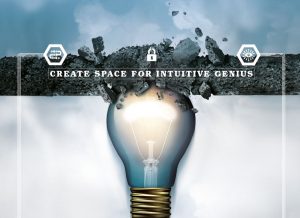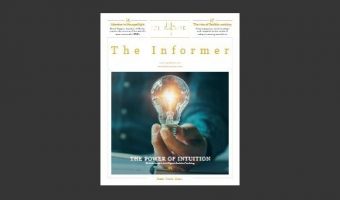News from in & around
The Clubhouse
Create Space for Intuitive Genius
How to cultivate intuitive intelligence for greater decision-making, creativity, and innovation, says consultant Rick Snyder

McKinsey conducted a survey and found that more than 70% of senior executives said that innovation is one of the top three drivers of growth in their companies and the most important way to accelerate the pace of change in today’s global business environment. Yet two-thirds of senior executives were not confident in how to stimulate and inspire innovation within their teams. In working closely with business leaders over the years, I’ve seen this same dilemma first-hand. It starts with creating the optimal environment for risk taking, intuitive thinking, and creativity to take place. Here is a four-step process that unlocks the creative genius in your company culture.
Step 1: Leaders go first
In order for intuitive intelligence to integrate into your strategy and activities, it has to start with members of the leadership team respecting and honouring their own intuition and creativity first. Leaders can foster intuitive decision-making by developing qualities such as receptivity, openness, vulnerability, curiosity, play, emotional intelligence, a willingness to not know, and making time to listen to their inner and outer environment. The more a leader is willing to break the ice and model the behaviour they expect to see, the more likely these values will be reflected in the company culture and others will learn that it’s OK to take risks, which is necessary for innovation to take place.
Step 2: Safety and risk
In order for a culture or a group of people to take a risk, they have to feel safe. In fact, Google conducted a two-year study and found that the highest-performing teams had one thing in common: psychological safety. An atmosphere of open communication, respect, and creativity is infectious and directly serves the company as employee participation skyrockets. A healthy company culture requires authentic communication about what’s really going on with staff, with customers, and with leadership. Building this level of trust is the basis of creating safety in the workplace and encouraging initiative. If you want outside-the-box solutions or honest feedback as a bare minimum, an environment of open dialogue is necessary.
Step 3: Encouraging intuition
The more you can facilitate a non-judgemental space in meetings and conversations, the more you will receive candor and feedback that you wouldn’t have conceived of on your own. Whether in a meeting or in the hallway, ask your staff what their gut sense is on a given situation. You will be surprised at the level of intelligence and directness that this encourages when you drop all pretences.
Step 4: Disruption
Disrupting normal ways of thinking allows your team to get out of their conscious, logical minds and into their subconscious, which is the birthplace of creativity and intuition, and allows your team to make faster and more integrated decisions. Stepping away from the computer or phone, going outside, engaging in a physical exercise, or finding a quiet space for mindfulness practice, all literally change your mind states where you can access your subconscious creativity and intuition and connect the dots in a fresh way. Warning! Embracing these approaches and techniques may result in your staff feeling more confident, thinking faster, embracing failure more easily, increasing awareness, improving listening skills, and learning how to read-out social dynamics and cues which directly relate to their role in the company. By breaking up routine patterns and modes of thinking, you are creating space for intuitive genius to flourish.
Rick Snyder is the founder and CEO of international consulting firm, Invisible Edge™. His breakthrough strategies based on his upcoming book, Decisive Intuition, have been implemented by executives and businesses in Europe, Canada, Asia, Africa, and America.
This article was originally featured in The Informer – February 2019. To read the full magazine please click here


